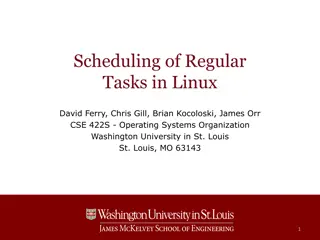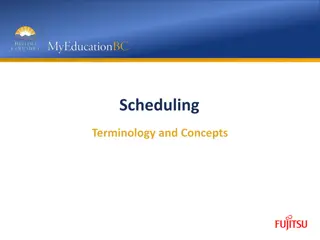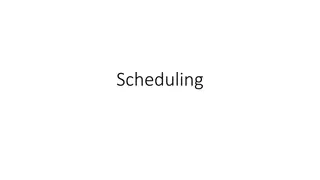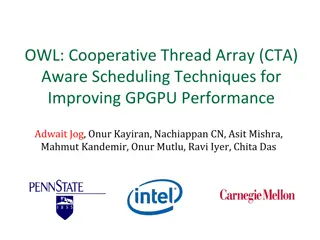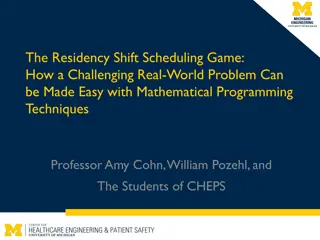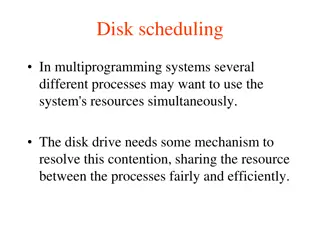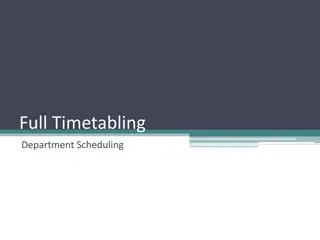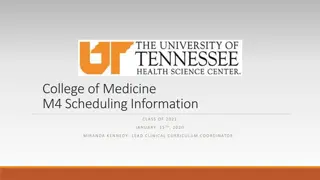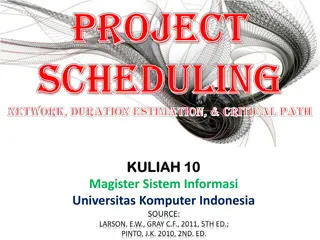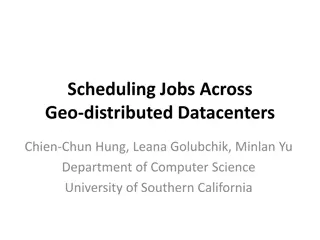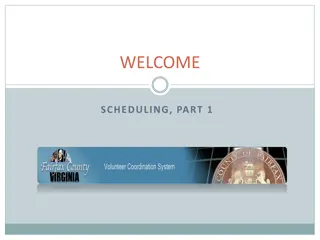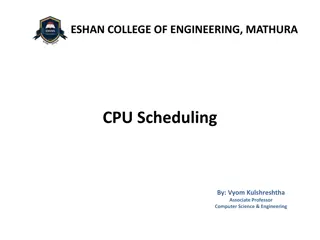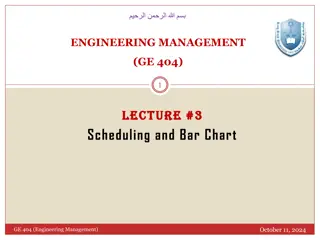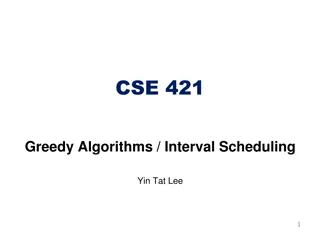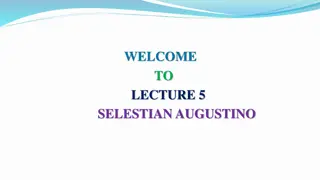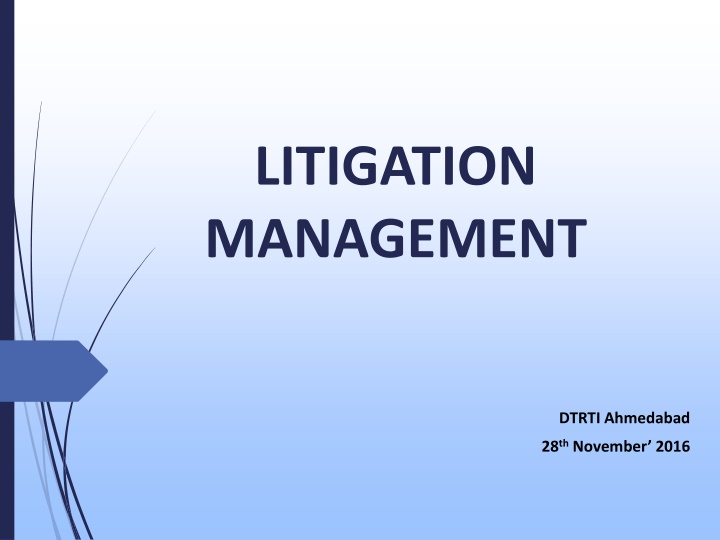
Software Project Scheduling and Delivery Challenges
This content discusses the basic concepts of project scheduling and tracking, software configuration management, user interface design, and computer-aided software engineering tools. It highlights reasons for late software delivery and provides solutions to overcome issues like unrealistic deadlines. Strategies are presented to meet imposed deadlines and manage project scheduling effectively.
Download Presentation

Please find below an Image/Link to download the presentation.
The content on the website is provided AS IS for your information and personal use only. It may not be sold, licensed, or shared on other websites without obtaining consent from the author. If you encounter any issues during the download, it is possible that the publisher has removed the file from their server.
You are allowed to download the files provided on this website for personal or commercial use, subject to the condition that they are used lawfully. All files are the property of their respective owners.
The content on the website is provided AS IS for your information and personal use only. It may not be sold, licensed, or shared on other websites without obtaining consent from the author.
E N D
Presentation Transcript
LITIGATION MANAGEMENT DTRTI Ahmedabad 28thNovember 2016
Handling Litigation Important & Essential Function of the Deptt. Litigation a natural outcome of Income Tax Law. No of assessees 5.5 crore Litigation Basket - scrutiny/148/263 under the Act/ Writs Increasing economic commercial transactions, rising incomes -varied interpretation of law. Pending litigation CIT(A) 2.58 lakh ( 1.4.16) ITAT 91122( 1.4.16) HC 35000 ( 1.10.16) SC 5581( 22.8.16) TDS, search action, CASS activity, complexities in
Appeal Filed FY 14-15 (Approx.) SC-1310 (5%) HC-25,000 (55%) ITAT- 45,000 (37%) CIT(A) 1.21 Lakh (32%) Scrutiny 3.8 Lakh (0.95%) Returns 4 Cr
Litigation Management Essential litigation & robust case management Role of Assessing Officers Role/ Responsibility of Officers, esp judicial work Role of CBDT. Role of Counsels /DRs /HCC/ DGIT (L&R). requirement Quality of Supervisory
Most Important constituent of LM- Officers Key to ELM strong order, well marshalled facts, sound in law, clarity in language. Requires - an Empowered & Knowledgeable Assessing Officer know the law , apply the law & defend the law Training, sharing, access to legal database Defend orders effectively/ Litigate sensibly opportunity to cover inadequacies/weaknesses through good representation. assist DR/ Brief Counsel appropriately Appeal not an orphan own up responsibility Officers handling litigation work o/o CIT, CCIT/Pr. CCIT / HC Cell discharge most crucial role not mere post offices- check point -delay , SQL, precedence , merit, swift communication Good coordination with courts for speedy disposal - bunching of appeals, continuous hearings, less adjournments
Role of Officers handling Judicial work Management of appeals - ITAT, HC and SC Filter appropriate cases based on Merit, Board Circular on monetary limits Share information, Monitor timely filing of appeals Follow cause list/ disposal list of HC and SC- take action
Important Instructions SOPs for filing appeals and appeal related processes 1. Ins. No. 8/11 2. Ins. No. 7/11 3. Ins. No. 4/11 4. Ins. No. 8/13 5. Cir. No. 21/15 6. Ins. No. 7/16 ITAT HC SC SC Monetary Limits Engagement/ payment of fees etc. to Counsels
Role of CBDT Provide clarity on contentious issues- OM dtd. 28.8.12 - state a Settled View/ Departmental View Amendments Manage litigation through policy measures i. SOPs laid down for filing /handling appeals ii. Monetary limits for filing appeals- Retrospective applicability withdraw appeals ii. Collegium approach iii. Advance pricing agreements iv. Dispute Resolution Schemes v. about improving quality of litigation Extensive workshops to sensitise /train Officers vi. Adoption of technology for ELM - NJRS
SOP for Litigation in SC Instruction Circular No.21/2015 No.4/2011, Instruction No.8/2013 & Govern the process to be adopted for filing of appeal/handling litigation in SC Minute details outlined/timelines prescribed to control delay in filing of SLPs Make litigation management effective and safe guard revenue interest. Monetary limits
SOP for filing SLP Instruction No.4/2011 (9.3.2011) Significant Points Timelines for SLP Annexure-A to Instruction No 4 (from date of judgement) Responsibility of obtaining High Court order on CIT/CCIT (para 4) Certified copy not pre-requisite for filing SLP [para 5(iii) & (iv)] Opinion of standing counsel, not necessary for proposing SLP [para 5(v)] Scrutiny report from AO dispensed with para 5(vi) Assessee s SLP para 6 of Instruction (counter affidavit)
Instruction No.8/2013 (16.7.2013) ASSESSEE S SLP & CAVEAT-SOP For HC orders in favour, CIT to decide whether caveat required to be filed in SC If yes, proposal + HC order + Vakalatnama in favour of AoR to Pr.DGIT (L&R) If no, record reasons In assessee s appeal prepare counter affidavit and related paper book Annexure-A to Instruction- complete detail of processes within specified time
Circular No. 21 of 2015 (10.12.15) Tax effect- only IT Rs 25 lakhs. Tax does not include interest For penalty- quantum of penalty deleted/reduced For composite order of HC: If tax 25 Lacs in One AY or More Ys- to be filed for all years. If more than one assessee- each separate consideration No monetary limit for Writ Petitions and other matters viz 12A etc. and in case of challenge to : Constitutional validity CBDT Notf./Cir./Inst. held illegal Revenue Audit objection accepted by Department Where addition relates to and disclosed foreign assets/ bank accounts
Cont.- Retrospective Application-Pending appeals in HC/ITAT To be withdrawn-less tax effect ones In SC - no retrospective effect. Instructions operative on date of filing
Proposals : Deficiencies Preliminary processing stage: Deficiency letter Common deficiencies Reasons for Delay - prescribed proforma; chronological sequence of events. Instructions of the Board not properly followed. SQL - Not properly framed. Proforma B - Incomplete
Action Points: CIT/DIT after Submitting proposals Check official e-mail Cut delay Sending proposals Queries raised by Directorate Vetting Incorrect calculation of Tax Effect for each question of law Vetting : 7 days Lack of input by the field on change in SQL made by Drafting Counsel Cases Refiled : Remove defects Half baked proposals: Supervisory Authorities responsible Monitoring: Performance of Counsels in HC No SLP: CIT to record reasons
Status of Proposals received as on 18.11.2016 2016-17 (31/10/2016) Particulars 2011-12 2012-13 2013-14 2014-15 2015-16 Total 1 2 3 4 5 6 7 8 Total Proposal Received 2282 1863 1467 1775 1434 956 9777 No. of SLP not approved by CBDT [Out of 1] 842 533 695 910 647 346 3973 % of Non approval by CBDT 36.9 28.61 47.38 51.3 45.12 36.19 40.64 Review Petition (No SLP)[Out of 2] 5 18 21 35 3 2 84 No. of SLP approved by CBDT [Out of 1] (4=1- 2) Pending at various stages (MoL&J/Under Process) [Out of 1] Appeals filed [SLP (CA/C/CC/Dy.) No. allotted [Out of 1] 1440 1330 772 865 787 610 5804 2 7 0 5 13 427 454 1438 1323 772 860 774 183 5350 SLP Dismissed [Out of 6] 839 534 344 236 98 18 2069 % of SLP Dismissal [Out of 6] 58.34 40.36 44.56 27.44 12.66 D. NA 38.67 Leave Granted [Out of 6] 153 173 90 186 219 11 832 % of Leave Granted [Out of 6] 10.64 13.08 11.66 21.63 28.29 D. N. A 15.55 Partly Allowed [Out of 6] 32 66 11 24 D. N. A D. N. A 133 Pending at various stages (Supreme Court)[ Out of 6] 414 550 327 414 457 154 2316
SLP Proposals of Gujarat Charge Issue Notice Leave Granted/ Allowed Pending in Supreme Court Total Proposal received Year NO SLP Dismissed 7/ 2011-12 377 110 (29%) 202 14 4/9 2013-14 236 145 (61%) 59 17 50/2 2014-15 363 264 (72%) 18 29 2015-16 137 79 (56%) D. N. A D. N. A D. N. A 2016-17 332 162 (48%) D. N. A D. N. A D. N. A
OM dated 28.8.2012 Set up an Institutional mechanism to resolve contentious legal Departmental View / Settled View - CTC at the level of CBDT & RTCs in every CCA charge. issues / formulate Purpose To provide clarity on contentious legal issues; To promote consistency of approach on a given issue and; To reduce litigation
Central Standing Committee in the Board Technical Committee- JS (TPL)-II, CBDT CIT(ITA), CBDT, CIT(OSD), Directorate of Income Tax (L&R), Member Secretary under supervision and control of Pr. DGIT (L&R) In August 2013, 2 members co-opted - Sh. Rajnish Kumar, CIT, Delhi and CIT (A&J), CBDT
Regional Technical Committee Each Pr. CCIT to constitute a "Regional Technical Committee" (RTC) consisting of : (i) One administrative CIT (ii) One CIT(DR) (iii) CIT(Audit) (iv) CIT(Judicial)/one CIT(A) (v) Addl. CIT(J)/Addl. CIT(Technical) in-charge of judicial work in Pr. CCIT office - Secretary to the RTC. The RTC may invite any other officer, conversant with the issues under deliberation, to its meetings.
RTC Gujarat (NEWLY CONSTITUTED) Pr. CIT-4- Ahmedabad, Chairman CIT (DR)-ITAT-2, Member CIT (Appeal)-13, Member CIT (Audit), Member CIT(Judl.), Member Addl. CIT (Judl.), Secretary Reference from the RTC- 3
Output of CTC Circular Issued Amendments 18 07
S.No. Circular No. Subject Section 10A r.w. Section 10AA& 10B of the Act, setoff& carry forward of business losses,(eligible& non eligible units-same head , other heads , b/f losses etc to be set off , deduction on balance income 7/2013, dated 16.07.2013 1 10/2013, dated 16.12.2013 Section 40(a)(ia) of the Act-on amounts payable during the year . 2 16/2015, dated 6/5.10.2015 Non-applicability of Rule 9A of the Income Tax Rules 1962.- abandoned feature film 3 Measurement of the distance for the purpose of section 2(14)(iii)(b) of the IT Act for the period prior to Assessment year 2014-15.- shortest distance by road . Amendment says aerially , prospective 17/2015, dated 06.10.2015 4
S.No. Circular No. Subject 18/2015, dated 02.11.2015 Interest from Non-SLR securities of Banks.- part of banking business 5 Allowability of employer s contribution to funds for the welfare of employees in terms of section 43B(b) of the IT Act- if paid by due date u/s 139(1) 22/2015, dated 17.12.2015 6 TDS under section 194A of the Act on interest on fixed deposit made on directions of Courts. On final order of court -receipt basis 23/2015, dated 28.12.2015 7
S.No. Circular No. Subject 24/2015, dated 31.12.2015 Recording of satisfaction note under section 158BD/153C of the Act.- necessary 8 Penalty disallowances made under normal provisions of the IT Act, 1961 but tax levied under MAT provisions u/s 115JB/115JC, for cases prior to A.Y. 2016-17.not attracted u/s 271(1)(c) wherein additions/ 25/2015, dated 31.12.2015 9 01/2016, dated 15.2.2016, F.No.200/31/2015- ITA-1 Clarification of the term initial assessment year in section 80IA(5) of the IT Act, 1961- means the first year opted by the assessee *10 Letter no 200/3/2016-ITA-1, dated 13.04.2016 Section 10(10C) of the Act-ERO 2003 Scheme benefit to all such retirees of ICICI Bank in light of SC judgement ( S.Palaniappan) *11
S.No. Circular No. Subject Commencement proceedings under section 271D and 271E of the IT Act, 1961 Range authority competent authority to issue notice , limitation therefrom of limitation for penalty 09/DV/2016, dated 26.04.2016 12 Limitation for penalty proceedings under sections 271D and 271E of the IT Act, 1961- section 275(1) (c ) 10/2016, dated 26.04.2016 13 Payment of interest on refund under section 244A of excess TDS deposited under section 195 of the IT Act, 1961.if resident deductor entitled for refund , corresponding interest to be given 11/2016, dated 26.04.2016 14 F.No. 225/12/2016/ITA -II, dated 02.05.2016 Consistency in taxability of income/loss arising from transfer of unlisted shares under Income Tax Act,1961-to be treated gains,irrespective of period of holding *15 as capital
S.No. Circular No. Subject Additional Depreciation u/s 32(1)(iia) of the Income Tax Act, 1961- printing or printing publishing amounts production of article or thing 15/2016, dated 18.05.2016 16 to manufacture or 21/2016, dated 27.5.2016, F.No.197/17/2016- ITA-1 Clarification registration u/s 12AA of the IT Act, 1961, in certain circumstances amendments clarified , regarding cancellation of *17 Bad Debt u/s 36(1)(vii) and 36(2) of the Income Tax Act, 1961- claim admissible if bad debt written off 12/2016, dated 30.05.2016 18 37/2016, dated 2.11.2016 Chapter VIA deduction on enhanced profits due to disallowances of expenditure claimed 19 Admissibility of expenditure incurred by a Firm on Keyman Insurance Policy in the case of a Partner. 38/2016, dated 22.11.2016 20
Substantial Question of Law As such there is definition of substantial question of law in the Income tax Act, however, several Courts certain guidelines, guidelines are fulfilled, it can be said that, the issue involves SQL. no specific have laid down these if,
Substantial Question of Law (Contd..) The tests to determine whether a question involved is one of fact or law: (a) As the Tribunal is the final fact-finding authority, if it has reached certain findings upon examination of all relevant evidence and materials before it, the existence or otherwise of certain facts at issue is a question of fact.
Substantial Question of Law (Contd..) (b) Any inference from certain facts is also a question of fact. (c) If a finding of fact is arrived at by the Tribunal after improperly evidence, a question of law arises. Where a Court of fact acts on materials partly relevant and partly irrelevant and it is impossible to say to what extent the mind of the adjudicating forum was rejecting (d)
Substantial Question of Law (Contd..) affected by the irrelevant material used by it in arriving at the finding, it gives rise to a question of law. Such a finding is vitiated because of the use of inadmissible material. (e) When any finding is based on no evidence or material, it involves a question of law. In other words, if the Tribunal acts on irrelevant materials and evidence, a question of law is involved.
K.S. Profiles From Field 1.Whether the Hon'ble High Court was right in facts and circumstances and in law in passing the impugned order as the same is contrary to facts and circumstances of the case. 2. That the impugned order is erroneous in law as well as on merits. 3. Whether the Hon'ble High Court was right in facts and circumstances and in law in holding that incentives in the form of exemption of excise duty received and retained by the appellant pursuant to the scheme of the Government of J&K constituted capital receipt not liable to tax under the provisions of the Act.
K.S. Profiles 4. Whether the Hon'ble High Court was right in facts and circumstances and in law in holding that interest subsidy received by the appellant pursuant to the scheme of the Government of J&K constituted capital receipt not liable to tax under the provisions of the Act. 5. Whether the Hon'ble High Court was right in facts and circumstances and in law in not appreciating the findings of the Tribunal that the incentives were available to industrial commencement of the commercial production. units only after the
K.S. Profiles From Field 6. Whether the Hon'ble High Court was right in facts and circumstances and in law in not appreciating the judgments of Hon'ble Supreme Court of India in the case of Ponni Sugar & Sawhney Steel and press Works Ltd. wherein the Hon'ble Supreme Court had held such receipts to be the revenue receipts in as much as in that case payments were made only after the industries had been set up and payments were not made for purpose of setting up of industries. 7. Whether the Hon'ble High Court was right in facts and circumstances and in law in not considering the decision in
K.S. Profiles the case of Seaham Harbour Dock Company which lays down two important tests for determining whether receipts is a trading receipt or a capital receipt. 8. Whether the Hon'ble High Court was right in facts and circumstances and in law in not appreciating and applied the purpose test as laid down by the judgments of the Hon'ble Supreme Court. In the case of assessee, the money received by the assessee on account of refund of Central Excise, Interest Subsidy and Transport Subsidy were not supposed to be spent in a particular manner for purpose of substantial expansion of the industry. 9. Appellant craves leave to amend or add any one or many grounds of appeal.
K.S. Profiles Reframed and filed 1. Whether the incentives received by the assessee in the form of excise duty refunds constitute capital receipt or revenue receipt? 2. Whether the assessee is entitled to deduction under section 80IB of the IT Act on the income arising on account of excise duty refund, as the same is not derived from an industrial undertaking?
Relevant e-mail Ids for WZ ADG-I- dit1.lr@incometax.gov.in JDIT(SCC) - ito1.scc.delhi@incometax.gov.in NJRS - njrs@incometax.gov.in CTC - ctc@incometax.gov.in
Pendency in 1984-85* 39 High Courts (a) Reference u/s 256(2) (b) Cases u/s 256 (c) Petition u/s 261 (d) Writs 7230 26139 489 3844 37702 Supreme Court (a) Appeals u/s 261 (b) SLP (c) Writs 1306 1592 336 3234 *150th Report on TAX COURTS , LAW COMMISSION 1986 DIT(L&R)-II
1983-84 No of assessments IT 8692824 WT-956000 GT-126000 Tax Collected IT-4130 cr WT-93.76 cr GT- 8.5 cr In yr 1860 Rs 1.50 cr , in 1864-65 -13 lac pounds Source: 100 years of Income Tax Department (1886-1995) published by Directorate of Inspection (Printing & Publication)

